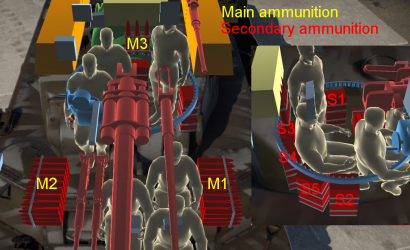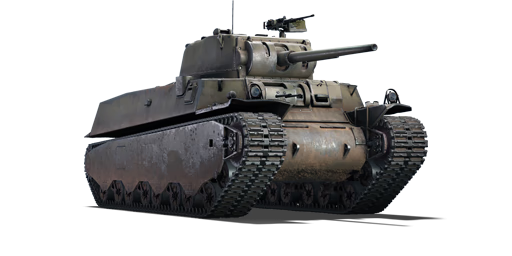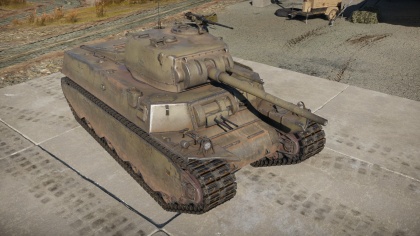M6A1
Contents
Description
The Heavy Tank M6A1 is a rank III American heavy tank
with a battle rating of 4.7 (AB) and 5.0 (RB/SB). It was one of the first American tanks to be released with the American ground tree in Update 1.45 "Steel Generals". A rather unusual tank design mounting two cannons in the turret, however, it has a durable frontal armour for the battle rating it occupies.
The M6A1 is one of the most unique tanks in the game, with its large hull and being as tall as a Tiger I. Another interesting feature is that it is one of the most manoeuvrable heavy tanks in the game with a powerful Wright G-200 engine (the same engine powering the B-17 Flying Fortress bomber) with a max speed of 35 km/h, making it very mobile in a battle situation. The tank has two 12.7 mm's in the hull which can be used but cannot be angled sideways. The M6A1 is one of the first American tanks as well in the game to have the transmission at the rear of the tank.
Something to keep in mind is the shell arc of the secondary 37 mm cannon. Its shell will usually hit the same spot on distances up to 1400 m (~1 mile). But do not forget that the gun is offset to the left in close combat, or it will not hit the target.
General info
Survivability and armour
Armour type:
- Cast homogeneous armour (Front, Transmission area, Turret)
- Rolled homogeneous armour (Front, Side, Rear, Roof)
| Armour | Front (Slope angle) | Sides | Rear | Roof |
|---|---|---|---|---|
| Hull | 82.5 mm (5-35°) Front 101.6 mm (5-35°) Transmission |
44.4 mm | 44.4 mm | 25.4 mm |
| Turret | 250 mm (6-65°) Turret front 50.8 + 50.8 mm (7-62°) Gun mantlet |
82.5 mm (0-12°) | 82.5 mm (0-68°) | 25.4 mm |
| Armour | Sides | Roof | ||
| Cupola | 82.5 mm | 25.4 mm |
Notes:
- Suspension wheels are 15 mm thick while tracks are 17 mm thick.
- Front armour is rounded so have variable slope angle along the surface.
- Side skirts are 25 mm Rolled Homogenous armour and will trigger fuses on any hostile APHE. If shot came at an angle, there is a high chance APHE won't be able to take out the ammo rack due to it exploding outside of the tank and spreading out the damage. Any pure AP shots with enough penetration power left will not be stopped and destroy your tank if they were aimed straight at ammo racks.
Mobility
| Mobility characteristic | ||
|---|---|---|
| Weight (tons) | Add-on Armor weight (tons) |
Max speed (km/h) |
| 56.8 | N/A | 37 (AB) |
| 35 (RB/SB) | ||
| Engine power (horsepower) | ||
| Mode | Stock | Upgraded |
| Arcade | 1,033 | 1,272 |
| Realistic/Simulator | 708 | 800 |
| Power-to-weight ratio (hp/ton) | ||
| Mode | Stock | Upgraded |
| Arcade | 18.19 | 22.39 |
| Realistic/Simulator | 12.46 | 14.08 |
Armaments
Main armament
| 76 mm M7 | |||||
|---|---|---|---|---|---|
| Capacity | Vertical guidance |
Horizontal guidance | |||
| 75 | -10°/+30° | ±180° | |||
| Turret rotation speed (°/s) | |||||
| Mode | Stock | Upgraded | Prior + Full crew | Prior + Expert qualif. | Prior + Ace qualif. |
| Arcade | 10.70 | 14.80 | 18.00 | 19.90 | 21.20 |
| Realistic | 10.70 | 12.60 | 15.30 | 16.92 | 18.0 |
| Reloading rate (seconds) | |||||
| Stock | Prior + Full crew | Prior + Expert qualif. | Prior + Ace qualif. | ||
| 7.67 | 6.78 | 6.25 | 5.90 | ||
Ammunition
| Penetration statistics | |||||||
|---|---|---|---|---|---|---|---|
| Ammunition | Type of warhead |
Penetration in mm @ 0° Angle of Attack | |||||
| 10m | 100m | 500m | 1000m | 1500m | 2000m | ||
| M62 Shell | APCBC | 127 | 125 | 116 | 106 | 97 | 89 |
| M42A1 Shell | HE | 7 | 7 | 7 | 7 | 7 | 7 |
| M79 Shot | AP | 155 | 154 | 131 | 107 | 88 | 72 |
| Shell details | |||||||||
|---|---|---|---|---|---|---|---|---|---|
| Ammunition | Velocity in m/s |
Projectile Mass in kg |
Fuse delay
in m: |
Fuse sensitivity
in mm: |
Explosive Mass in g (TNT equivalent): |
Normalization At 30° from horizontal: |
Ricochet: | ||
| 0% | 50% | 100% | |||||||
| M62 Shell | 792 | 7 | 1.2 | 20 | 63.7 | +4° | 48° | 63° | 71° |
| M42A1 Shell | 800 | 5.8 | 0.1 | 0.5 | 390 | +0° | 79° | 80° | 81° |
| M79 Shot | 792 | 6.8 | N/A | N/A | N/A | -1° | 47° | 60° | 65° |
Ammo racks

| Full ammo |
1st rack empty |
2nd rack empty |
3rd rack empty |
Visual discrepancy |
|---|---|---|---|---|
| 75 | 40 (+35) | 4 (+71) | 1 (+74) | Yes |
Additional armament
| 37 mm M3 | |||||
|---|---|---|---|---|---|
| Capacity | Vertical guidance |
Horizontal guidance | |||
| 202 | N/A | N/A | |||
| Reloading rate (seconds) | |||||
| Stock | Prior + Full crew | Prior + Expert Qualif. | Prior + Ace Qualif. | ||
| 3.77 | 3.33 | 3.07 | 2.90 | ||
Ammunition
| Penetration statistics | |||||||
|---|---|---|---|---|---|---|---|
| Ammunition | Type of warhead |
Penetration in mm @ 0° Angle of Attack | |||||
| 10m | 100m | 500m | 1000m | 1500m | 2000m | ||
| M74B1 | AP | 90 | 89 | 69 | 50 | 37 | 27 |
| M63 Shell | HE | 2 | 2 | 2 | 2 | 2 | 2 |
| M51B1/B2 | APC | 79 | 78 | 69 | 59 | 51 | 43 |
| Shell details | |||||||||
|---|---|---|---|---|---|---|---|---|---|
| Ammunition | Velocity in m/s |
Projectile Mass in kg |
Fuse delay
in m: |
Fuse sensitivity
in mm: |
Explosive Mass in g (TNT equivalent): |
Normalization At 30° from horizontal: |
Ricochet: | ||
| 0% | 50% | 100% | |||||||
| M74B1 | 883 | 0.87 | N/A | N/A | N/A | -1° | 47° | 60° | 65° |
| M63 Shell | 807 | 0.73 | 0.1 | 0.5 | 38 | +0° | 79° | 80° | 81° |
| M51B1/B2 | 883 | 0.87 | N/A | N/A | N/A | +4° | 48° | 63° | 71° |
Ammo racks
| Full ammo |
1st rack empty |
2nd rack empty |
3rd rack empty |
4th rack empty |
5th rack empty |
6th rack empty |
Visual discrepancy |
|---|---|---|---|---|---|---|---|
| 202 | 85 (+12) | 161 (+41) | 121 (+81) | 81 (+121) | 41 (+161) | 1 (+201) | Yes |
Machine guns
| 12.7 mm M2HB | ||||||
|---|---|---|---|---|---|---|
| Pintle mount | ||||||
| Capacity (Belt capacity) | Fire rate (shots/minute) |
Vertical guidance |
Horizontal guidance | |||
| 1,000 (200) | 576 | -10°/+50° | ±120° | |||
| Hull mount #1 | ||||||
| Capacity (Belt capacity) | Fire rate (shots/minute) |
Vertical guidance |
Horizontal guidance | |||
| 3,000 (200) | 576 | -10°/+35° | ±15° | |||
| Hull mount #2 | ||||||
| Capacity (Belt capacity) | Fire rate (shots/minute) |
Vertical guidance |
Horizontal guidance | |||
| 3,000 (200) | 576 | -10°/+35° | ±15° | |||
Usage in battles
The M6A1 is at first a powerful machine with a 76 mm gun able to penetrate the front of most Rank III tanks. Once, bought make sure to stay behind cover as much as possible as one good hit can knock out the 76 mm gun. Another note is that with all multi-gun tanks, the secondary gun should be fired separately to maximize the efficiency of the shells. Since the tank is at Rank III, beware of IS-1s,Panthers, Tigers and Jumbos as they can all easily penetrate the weak frontal armour. Make sure to keep the rear safe as the M6A1's engine is very large for a heavy and is likely to set fire on the first hit. The M6A1 is only as powerful as to how the player uses it to its advantages.
Pros and cons
Pros:
- Great main 76 mm gun with a secondary to ward off some low-priority threats
- Good gun depression
- Reload rate isn't generally affected when losing crew members
- Has .50 cal AA machine gun, as well as a dual-mount .50 cal in front
- First standard heavy tank in the US tree, which can dish out and take punishment equally
- Lower portion of the hull sides are protected by additional 25.4 mm armour sheet
- Adequate roof armour of 25 mm means aerial strafing will be of a little issue without large-calibre weaponry
- Rear mounted transmission means it is not affected with a frontal penetration
- Big hull increases the chance of surviving after a penetrating hit
- Good acceleration and power-to-weight ratio
- Good hill-climbing abilities
- Very good cross country performance due to large tracks
Cons:
- Lots of weak armour points, such as gun mantlet, upper side armour, driver port, MG port, and front armour cheeks
- Armour profile overall is quite flat, no angling benefits
- Ammo is stored in the lower side armour
- All automotive module mounted in the rear, easily prone to damage, set ablaze, or exploded when shot
- Slow top speed
- Mediocre turn speed
- Pretty large in general, will stand out in the battlefield
History
Development
When World War II broke out, limited development in the United States meant that the military possessed very few tanks and so development hastened and eventually gave them tanks such as the M3 Lee and M4 Sherman. On May 20, 1940, the US Army Ordinance Corps began to work on a 50-ton heavy tank for their army. Initially, it was going to have a multi-turret design, two turrets with the 75 mm gun and one secondary turret with a 37 mm gun with a coaxial machine gun, then one more with a 20 mm gun with coaxial. Plus, four .30 cal machine guns were to be put on ball mounts on the front glacis and rear corners of the hull. This project was approved on June 11, 1940, and moved on as the Heavy Tank T1. However at the same time, similar concepts in Europe of heavy breakthrough tanks such as the Soviet T-35 and the German Neubaufahrzeug tanks were falling out of favour due to lack of combat effectiveness and unfavourable performance for their cost, and the US did the same in October so the design was changed.
The tank now had one turret with a 3-inch (76.2 mm) gun alongside a coaxial 37 mm gun. The turret housed three crew members and was powered by an electrical traverse system. The commander's cupola was copied from the M3 Lee, featuring a hatch with it sown machine gun. Two .50 cal machine guns now protruded from the bow mount (fired by bow gunner) and two .30 cal machine guns as well (fired by the driver). The entire tank held six crew members, the commander, gunner, driver, assistant driver, loader #1, and loader #2. While the construction of the vehicle was feasible, the engine was not enough to power the vehicle reliably due to heavy 57-ton weight.
In 1941 to 1942, three prototypes were constructed with the different transmission, one with electrical and the rest with a torque converter. The ones with the torque converters were designated the Heavy Tank M6 and M6A1. The electrical transmission design designated M6A2, was never approved by Ordinance, but was to be manufactured anyway. It was hoped that 115 of these tanks could be built for further testing and production started in December 1942 with design changes. The commander's cupola now featured a regular hatch rather than the machine gun one, which was removed along with one of the machine gun in the front hull. By the time the M6 was ready for production, the Army was moving forward and interest waned on these heavy tanks with the M4 Sherman's performance in the war. The M6's armour was only slightly thicker than the Sherman's and the 3-inch gun didn't offer too much improvement over the 75 mm gun, plus it had a large profile and low ergonomics, not to mention mechanical issues.
Production and cancellation
In early 1942, the M6 production was set for 250 a month but was cut down in September from 5,000 to a mere 100 when manufacturing focus moved to planes. By the end of 1942, Sherman's performance in the war proved its role in the war was more adaptable than the M6 heavy tank while remaining cheaper and lighter for transportation and supplying. This caused the M6 production to lower even more to just 40, before being shut down. Though testing with a 90 mm gun found the M6 to be a good gun mount, the poor layout of the tank restricted it, and the project was shut down before further development could be made.
In August 1944, the Ordinance Corps planned to modify some of the M6 heavy tanks with more armour and heavier armament to breach fortified areas. These were to be the M6A2E1 and weighed 77 tons with a 190 mm front armour and a 105 mm gun. Eisenhower rejected these as impractical and cancelled it. The M6 was found to be obsolete by December 1944 with only 40 units produced and never seeing combat service. They served as a propaganda piece during the war and were all scrapped after it except one, which is put on display at Aberdeen, Maryland at the United States Army Ordinance Museum. During development, the M6 turret was modified to become the turret for the M10 Tank Destroyer.
In-game description
"At the end of May 1940 the US infantry chief of staff responsible for armor put together requirements for future tanks in light of what was happening in Europe: the German army was relentlessly moving toward France and using armor with great success along the way. The Wehrmacht's use of new Pz.IV tanks with 75 mm guns instantaneously made the American tanks and their 37 mm cannons obsolete.
The new tank type had to be heavy (around 50 short tons), with 76 mm and 37 mm cannons arranged side-by-side in the turret. It had four machine guns (two heavy caliber and two rifle caliber), a Wright G-200 engine, a Hydromatic transmission, and a top speed of 25 mph. The green light was given for the construction of four prototypes in February 1941.
The prototypes developed by the Baldwin Locomotive Works were designed with different transmissions and hulls in the interests of finding the best option for full-scale production. Two modifications at most were permitted, and on April 13, 1942, the T1E2 and T1E3 were standardized as the M6 and M6A1. The latter added a welded hull, Wright G-200 engine, and torque converter to the M6.
Mass production was scheduled for November 1942, though a report by General Jacob Devers on December 7 indicated that the M6s would enjoy only limited tactical use due to their size. Moreover, two M4s equipped with 75 mm and 76 mm weapons could be built in place of two heavy tanks. As a result, the Armored Corps hurried to revoke the contract.
Between 1942 and 1943 the Baldwin Locomotive Works ended up producing 12 M6 heavy tanks. They did not join the army or see combat."
Media
Excellent additions to the article would be video guides, screenshots from the game, and photos.
See also
Links to the articles on the War Thunder Wiki that you think will be useful for the reader, for example:
- reference to the series of the vehicles;
- links to approximate analogues of other nations and research trees.
External links
| USA heavy tanks | |
|---|---|
| M4 Jumbo | M4A3E2 · Cobra King · M4A3E2 (76) W |
| M6 | M6A1 · T1E1 · T1E1 (90) · M6A2E1 |
| T26 | T26E1-1 · T26E5 |
| T29/30/34 | T29 · T30 · T34 |
| T32 | T32 · T32E1 |
| M103 | M103 |
| Others | T14 |





